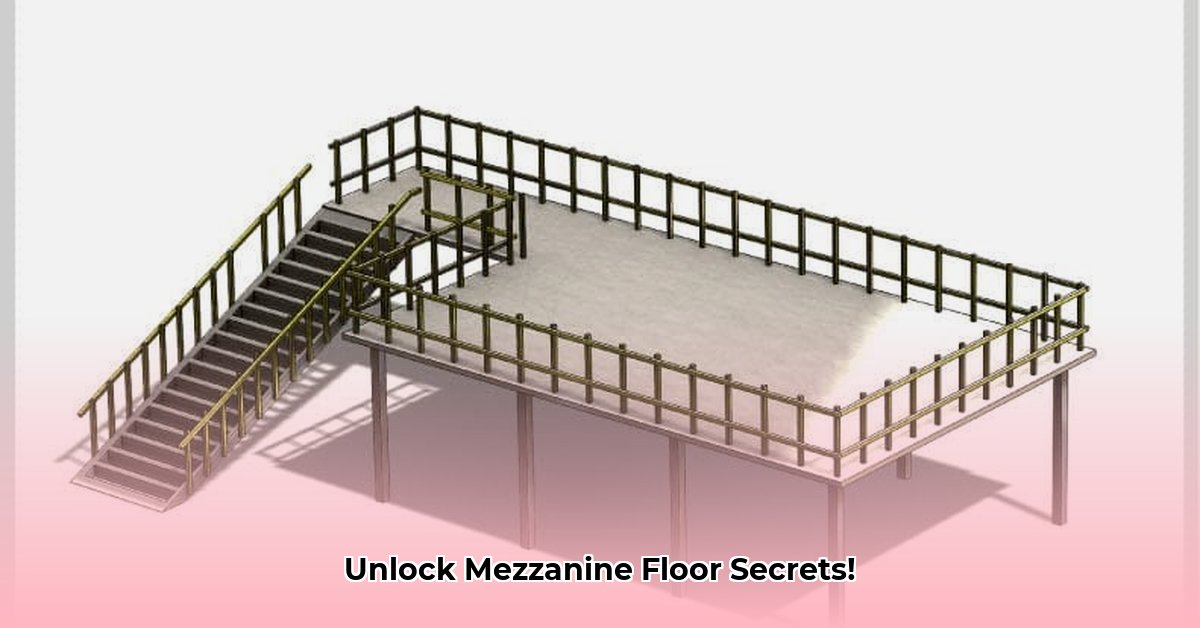Want to expand your building’s usable space without a major overhaul? This guide provides a comprehensive overview of mezzanine floor construction, covering material selection (steel, wood, and alternatives), structural design for safety and durability, and long-term maintenance strategies. Whether you’re a building owner, architect, or contractor, this article equips you with the knowledge to construct a practical and lasting mezzanine. We’ll navigate critical choices and common errors, empowering you to build with certainty. For detailed design standards, see these guidelines.
Understanding Mezzanine Construction: Essential Elements
Building a mezzanine is an efficient way to increase space, but attention to detail is paramount. This guide provides a thorough walkthrough, helping you avoid common mistakes and create a durable and efficient addition to your building. What is the critical factor in ensuring a mezzanine’s longevity? It’s a combination of sound planning, precise execution, and ongoing maintenance.
Mezzanine Planning: Setting the Groundwork
Thorough planning is essential before construction begins. Assessing your budget, space requirements, and intended use determines the appropriate mezzanine type. Will it bear heavy machinery or lighter loads? Clearly define the mezzanine’s purpose – storage, office space, retail display – as this dictates load requirements and design considerations. Considerations such as access (stairs, lifts, ramps) during this stage prevent complications later. Consider the flow of people and materials within the space.
Selecting Material: Steel, Wood, or Alternatives
Material choice affects a mezzanine’s appearance and strength. Steel provides exceptional strength for heavy loads and is ideal for industrial settings, but might be costly and less aesthetically pleasing than wood. Wood offers affordability and visual appeal, suitable for office or retail environments, but requires fire safety and rot prevention treatments. Concrete suits specific high-strength situations needing fire resistance. Aluminum is lightweight and corrosion-resistant, offering an alternative to steel in some applications. Modular systems provide flexibility and faster installation. The right material depends on your needs and budget. Did you know that using modular mezzanine systems can reduce installation time by up to 40% compared to traditional construction methods? Furthermore, consider the environmental impact of your material choices, opting for sustainable options whenever possible.
Load Capacity: Core of Mezzanine Design
Calculating load capacity is key, considering both the mezzanine’s weight (dead load) and the anticipated weight of equipment, people, and supplies (live load). Dead load includes the weight of the mezzanine structure itself (flooring, supports, railings). Live load is the variable weight the mezzanine will hold, including people, furniture, equipment, and stored items. Underestimation can be disastrous, leading to structural failure. Consult a structural engineer to determine the required load capacity based on design and materials. They will assess building codes and safety factors to ensure the mezzanine can safely handle the intended load.
Safety Regulations: Codes and Practices
Safety is critical. Comply with building codes and regulations, including fire safety features (sprinklers, fire-resistant materials), escape routes, and accessibility (ADA compliance). Consider factors like fire-resistance ratings for materials, sprinkler system design, emergency lighting, and clearly marked exit routes. Safety should be viewed as a priority and must not be taken lightly. Regular inspections and maintenance of safety equipment are also crucial.
Construction Process: Overview
While specifics vary, most mezzanine constructions follow these steps:
- Foundation Preparation: Ensure a strong, level base to support the entire structure’s weight. This may involve reinforcing the existing floor or pouring a new concrete slab.
- Support Structure Erection: Build the load-bearing framework (columns, beams, girders). Steel columns are typically anchored to the floor and connected to horizontal beams to create a stable frame.
- Deck Installation: Secure the floor of the mezzanine to the support structure. This may involve bolting or welding the decking material to the frame.
- Finishing: Install railings, stairs, and other finishing materials. Railings should meet safety code requirements, and stairs should be designed for comfortable and safe access.
- Inspections and Compliance: Regular checks ensure code compliance. Inspections should be conducted by qualified professionals to verify structural integrity and safety.
Cost Analysis: Investment
Mezzanine construction costs vary with materials, size, design complexity, and labor. Steel offers longevity and durability that may justify higher initial costs. Wood is generally more affordable but may require more maintenance. Modular systems often balance speed and affordability. Consider the cost of permits, engineering fees, and potential disruptions to business operations during construction. Obtain quotes from multiple contractors and compare carefully, considering long-term maintenance costs.
Maintenance: Longevity
Proper maintenance extends a mezzanine’s lifespan. Regular inspections identify potential issues early. Steel may require repainting for rust prevention, while wood needs checks for rot and insects. Inspect connections for looseness, and address any signs of wear or damage promptly. Develop a maintenance schedule to ensure the mezzanine remains safe and functional.
Risk Analysis: Proactive Mitigation
Planning for potential problems is crucial. The table below outlines potential risks and mitigation strategies.
| Risk Factor | Likelihood (Estimate) | Severity (Estimate) | Mitigation Strategy |
|---|---|---|---|
| Structural Failure | Low | High | Thorough structural engineering, regular inspections, use of certified materials, adherence to building codes |
| Fire Hazard | Medium | High | Use fire-retardant materials, incorporate fire suppression systems (sprinklers, fire extinguishers), fire alarms |
| Cracking/Settlement | Low | Medium | Proper foundation preparation, soil testing, quality control during construction, proper drainage |
| Installation Errors | Medium | Medium | Detailed plans, experienced and qualified installers, on-site supervision, quality control checks |
| Material Defects | Low | Medium | Use reputable suppliers, inspect materials upon delivery, quality control testing |
| Code Violations | Low | High | Thorough review of building codes, consultation with code officials, independent inspections |
By considering these details, you can build a safe and cost-effective mezzanine. Always consult professionals for tailored design and construction plans.
Mezzanine Floor Load Bearing Capacity Calculation: A Deep Dive
Accurately determining a mezzanine floor’s load capacity is crucial for structural integrity. This involves understanding dead loads and live loads. While online calculators provide initial estimates, a professional engineering assessment is essential for complex projects and ensures code compliance. How critical is the role of material science in determining a mezzanine’s load-bearing capacity? Material science dictates the inherent strength and properties of the materials used, directly impacting the structure’s ability to withstand loads.
Key Points:
- Accurate understanding of a mezzanine floor’s load-bearing capacity is vital for structural soundness.
- Calculate both dead loads (floor weight) and live loads (variable weights).
- Professional assessments are crucial for complex projects.
- Consider safety factors to account for unexpected loads or variations.
Load Types: Understanding Distribution
Dead loads are the weight of the structure itself, including flooring, beams, columns, and any permanent fixtures. Live loads are variable weights such as people, equipment, furniture, and stored materials. Uniformly distributed loads (UDL) are easier to calculate compared to concentrated point loads, where the weight is focused on a small area. Consider both UDLs and point loads in your calculations.
Calculation: Simplified Yet Comprehensive
The basic formula involves calculating the total dead load, estimating the maximum live load, applying a safety factor, and ensuring the combined load is within the material’s capacity. A structural engineer will use more sophisticated calculations, considering factors like bending moments, shear forces, and deflection. Professional engineering input is strongly advised.
Material Influence: Impact on Load
Material notably impacts load-bearing abilities. Steel offers superior strength and is suitable for heavy loads, while wood is more cost-effective for lighter loads, and composites balance benefits. Concrete provides excellent compressive strength for specific high-load applications. The material’s yield strength, tensile strength, and modulus of elasticity are critical factors in determining its load-bearing capacity.
Software and Expertise: Ensuring Accuracy
Software can provide detailed structural analysis, simulating load distribution and identifying potential weak points. However, engineering expertise is critical to interpret the results and ensure code compliance. A qualified engineer ensures code compliance and can identify potential issues that software might miss.
Regular Inspection: Proactive Maintenance
Inspections and maintenance ensure long-term safety. Regular inspections help prevent accidents and identify signs of wear or damage. Look for signs of deflection, cracking, or corrosion, and address any issues promptly.
Vertical Space Maximization with Mezzanine Floors in Retail Environments
Mezzanine floors effectively increase retail space and reduce costs associated with expansion or relocation. Proper planning is critical for successful integration and compliance with building codes. Prefabricated systems speed up installation and minimize disruption to business operations. Safety, including accessible handrails, fire exits, and clear signage, is crucial.
Core Insights:
- Mezzanine floors offer a cost-effective means to expand retail space.
- Material selection impacts load capacity, safety, and aesthetics, contributing to the customer experience.
- Planning is crucial for successful integration and building code compliance.
- Design should enhance the retail environment and customer flow.
Mezzanine Planning for Retail: A Detailed Approach
Assess the existing floor’s load capacity to ensure it can support the additional weight. Develop detailed design plans, including dimensions, load calculations, and material specifications. Check local building codes and acquire necessary permits. The design should integrate seamlessly with the retail space, enhancing the customer experience. Consider
- Glass Mosaic Backsplash: A Stylish Upgrade For Your Kitchen - December 8, 2025
- Glass Tile Shower Ideas to Create a Stunning Bathroom Space - December 7, 2025
- Glass Wall Tile Ideas for Kitchens and Bathrooms - December 6, 2025










